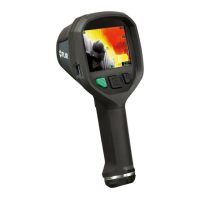Operation
12
12.5 Selecting camera modes
12.5.1 General
The camera features five different camera modes. You select the camera mode by push-
ing the Mode button.
The five different camera modes are:
1. Basic mode.
2. Black and white firefighting mode.
3. Fire mode.
4. Search and rescue mode.
5. Heat detection mode.
Each mode is optimized for a certain type of firefighting application. In addition, the
modes differ in the following way:
• Modes with green icons (1–3 in the list): The camera switches between the high-sen-
sitivity range (–20 to +150°C (–4 to +302°F)) and the low-sensitivity range (0 to +650°
C (+32 to +1202°F)) automatically when objects with a temperature above 150°C
(302°F) enter the field of view of the camera.
• Modes with blue icons (4–5 in the list): The temperature range is locked to the high-
sensitivity range (–20 to +150°C (–4 to +302°F)). This is useful if you need to maintain
the best possible image for objects with a temperature below 150°C (302°F), even if
there are objects with a temperature above 150°C (302°F) in the field of view of the
camera.
12.5.1.1 Automatic temperature range selection
12.5.1.1.1 General
The automatic temperature range selection is based on a measured area defined by a
rectangle covering (x1, y1) = (15% of the width, 15% of the height) to (x2, y2) = (85% of
the width, 85% of the height) of the LCD area. See the figure in section 12.5.1.1.2.
An automatic change from the high-sensitivity range to the low-sensitivity range occurs if
more than 2% of the pixels within the measured area constantly (for more than 1 second)
have a temperature above the maximum temperature of the high-sensitivity range.
An automatic change from low-sensitivity range to high-sensitivity range occurs if more
than 98% of the pixels within the measured area constantly have, for more than 1 sec-
ond, a temperature lower than 50°C (122°F) below the maximum temperature of the
high-sensitivity range.
12.5.1.1.2 Figure
#T559946; r. BA/41926/41970; en-US
28

